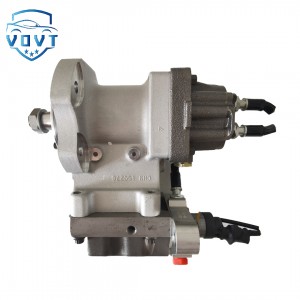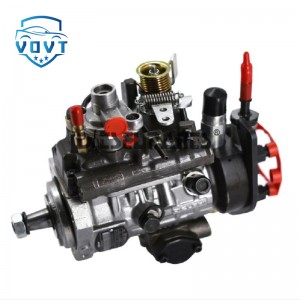Diesel Fuel Injection Pump 189-5184 For CAT Engine Auto Engine Part
products description
| Reference Code | 189-5184 |
| MOQ | 1 PCS |
| Certification | ISO9001 |
| Place of Origin | China |
| Packaging | Neutral packing |
| Quality Control | 100% tested before shipment |
| Lead time | 7~15 working days |
| Payment | T/T, Western Union, Money Gram, Paypal, Alipay, Wechat |
Introduction of diesel fuel pump
Structure and Principle
Structure: Diesel oil pumps are usually composed of main components such as pump body, plunger, plunger sleeve, oil outlet valve, oil outlet valve seat, camshaft, roller body, etc. The pump body is the outer shell of the oil pump, which plays the role of supporting and fixing other components. The plunger and plunger sleeve are the core moving parts of the oil pump, and a high-precision matching clearance is formed between them. The oil outlet valve and the oil outlet valve seat are used to control the output of fuel to ensure that the fuel enters the injector at the specified time and pressure. The camshaft drives the plunger to reciprocate through the roller body, thereby realizing the suction and extrusion of fuel.
Working principle: When the camshaft rotates, the cam pushes the roller body, causing the plunger to reciprocate up and down in the plunger sleeve. When the plunger moves downward, the volume of the space above the plunger increases, forming a local vacuum. Under the action of atmospheric pressure, the diesel in the fuel tank enters the space above the plunger through the oil inlet to realize the oil suction process. When the plunger moves upward, the fuel above the plunger is compressed and the pressure increases. When the pressure reaches a certain value, the spring force of the oil outlet valve is overcome, the oil outlet valve is pushed open, and the fuel is pressed into the high-pressure oil pipe through the oil outlet and delivered to the injector to complete the oil compression process.
Type
Inline plunger pump: The plungers of the inline plunger pump are arranged in a straight line, and each plunger corresponds to a cylinder. It drives the plunger to reciprocate through the rotation of the camshaft to achieve fuel pressurization and delivery. This oil pump has a simple structure and reliable operation, and is widely used in various diesel engines.
Distribution pump: The distribution pump distributes fuel to the injectors of each cylinder. It consists of a rotating distribution rotor and a fixed distribution sleeve, and the fuel is distributed by the rotation of the rotor. The distribution pump has the advantages of small size, light weight, and low cost. It is often used in small diesel engines and some vehicles with high space requirements.
High-pressure common rail pump: The high-pressure common rail pump is a common oil pump in modern diesel engines. It pressurizes the fuel to a high pressure state and distributes the high pressure fuel to each injector through the common rail pipe. The high pressure common rail pump can accurately control the injection pressure, injection time and injection amount of the fuel, thereby improving the combustion efficiency of the engine, reducing emissions and noise.
Performance parameters
Fuel supply: The fuel supply of a diesel fuel pump refers to the amount of fuel that can be delivered per unit time. The amount of fuel supply directly affects the power and torque output of the engine. Different types of diesel engines have different requirements for the fuel supply of the fuel pump, which is generally determined according to factors such as the engine's displacement, speed and load.
Fuel supply pressure: The fuel supply pressure refers to the pressure at which the fuel pump outputs the fuel. Sufficient fuel supply pressure is essential to ensure the normal operation of the injector and good atomization of the fuel. The fuel supply pressure of modern diesel engines is usually high, generally between tens of megapascals and hundreds of megapascals.
Injection advance angle: The injection advance angle refers to the time when the injector starts to spray relative to the time when the engine piston reaches the top dead center. A suitable injection advance angle can enable the fuel to be fully burned in the cylinder and improve the thermal efficiency and power performance of the engine. The size of the injection advance angle is related to factors such as the engine speed and load, and is generally automatically adjusted by the engine control system according to the actual working conditions.
Maintenance and maintenance
Regularly replace the fuel filter: The fuel filter can filter out impurities and moisture in the fuel to prevent them from entering the fuel pump and causing wear and blockage of the fuel pump. It is generally recommended to replace the fuel filter after a certain mileage or a certain period of use.
Keep the fuel clean: Using clean fuel is the key to ensuring the normal operation of the fuel pump. When refueling, you should choose a regular gas station to avoid adding fuel containing impurities and moisture. At the same time, you should clean the fuel tank regularly to prevent impurities and moisture in the fuel tank from entering the fuel pump.
Check the sealing of the fuel pump: Check the sealing of the fuel pump regularly to prevent fuel leakage. If the fuel pump is found to be leaking, the cause should be found and repaired in time to avoid damage to the fuel pump and engine failure due to fuel leakage.
Perform maintenance on time: Perform maintenance and maintenance on the diesel fuel pump on time according to the requirements of the engine's instruction manual. The maintenance content includes checking the wear of various components of the fuel pump, adjusting the injection advance angle, cleaning the outside of the fuel pump, etc. Some severely worn parts should be replaced in time to ensure the performance and reliability of the oil pump.





























